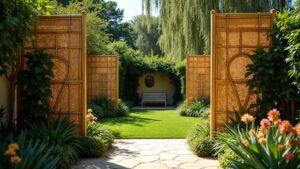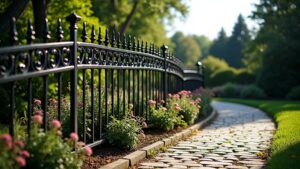Looking to enhance your property with eco-friendly fencing? Consider options like bamboo, composite materials, living fences, recycled metal, salvaged wood, stone, recycled plastic, cap-composite, and woven hurdle fencing. These materials not only look great but also promote sustainable living by reducing waste and supporting biodiversity. Each option has its own benefits, helping you create a beautiful and environmentally-friendly yard. Explore these materials to find the perfect fit for your space!
Key Takeaways
- Bamboo fencing is a fast-growing, biodegradable, and pest-resistant material, making it an eco-friendly option for privacy and style.
- Composite fencing, made from recycled materials, offers the look of wood with added durability and low upkeep.
- Living fences, created from plants, boost biodiversity and need minimal resources, providing natural privacy while supporting local wildlife.
- Stone and recycled metal fencing are durable, low-maintenance, and help create habitats for animals, making them environmentally friendly choices.
- Alternative options like recycled plastic and woven hurdle fencing enhance sustainability while adding visual interest to outdoor spaces.
Bamboo Fencing
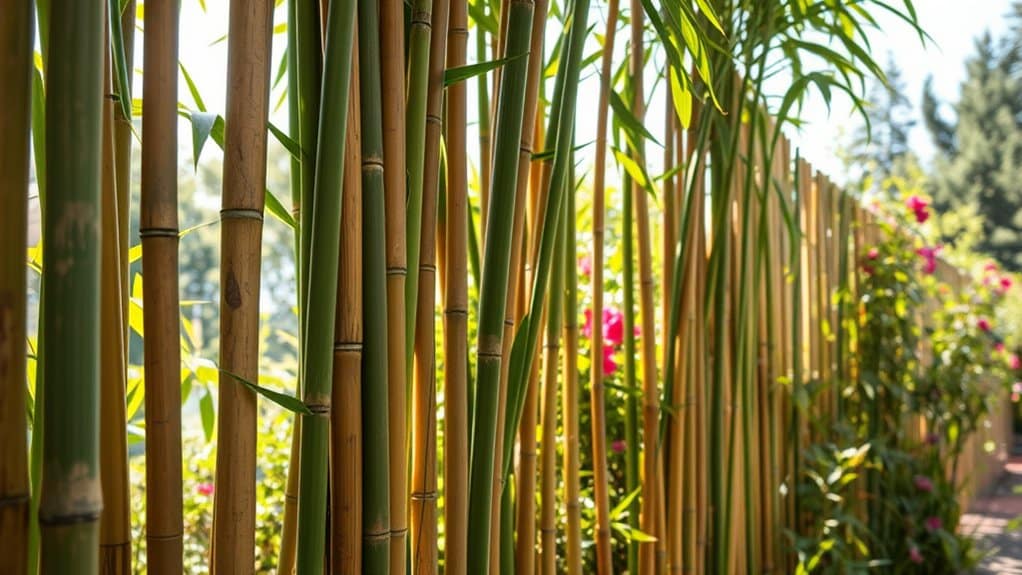
If you want an eco-friendly fencing option, bamboo fencing is a great choice. Bamboo grows quickly and absorbs more carbon dioxide than traditional wood, making it a sustainable material. Its natural silica content makes it resistant to pests and rot, which means you won’t need to use harmful chemicals. Plus, it’s biodegradable, so it won’t contribute to waste when it’s time to replace it.
Aesthetically, bamboo fencing adds a unique tropical vibe to any outdoor area, fitting well with both modern and traditional styles. With different options like slats and panels, you can create a design that suits your needs while ensuring privacy. By opting for bamboo, you enhance your space’s beauty and support a sustainable environment.
Choose bamboo fencing for a greener future!
Composite Fencing

Choosing composite fencing means you get a strong, attractive option that blends the look of wood with the durability of recycled materials.
This environmentally friendly choice boosts your property’s appeal while minimizing your carbon footprint.
With numerous styles and colors available, you can easily find what suits your home.
Plus, it offers lower maintenance and a longer lifespan compared to traditional fencing. Additionally, composite fencing is resistant to termite damage, ensuring that your investment remains protected over time.
Benefits of Composite Fencing
Composite fencing stands out for homeowners due to its impressive benefits. It lasts 30-50 years and resists rot, decay, and pests, making it a tough choice. Made from recycled materials, it helps reduce landfill waste and preserves forests, making it an eco-friendly option. Additionally, its long lifespan means that it provides better long-term value compared to traditional wood fencing. Furthermore, choosing durable materials like composite ensures that homeowners won’t need to frequently replace their fencing, enhancing sustainability efforts. You’ll save on maintenance and repairs over time, as it requires minimal upkeep and no harmful chemicals.
Design Versatility Options
Composite fencing offers great durability and eco-friendliness, along with impressive design versatility.
With a variety of colors to choose from, you can easily find shades that match your style without the need for painting. The texture options, like reversible panels with woodgrain or brushed finishes, allow for even more customization.
You can mix and match different panel configurations and heights, whether you prefer horizontal or vertical slatting. Plus, composite fencing works well with materials like aluminum, enhancing your outdoor space.
Environmental Impact Overview
Want to positively impact the environment while enhancing your outdoor space? Choose composite fencing.
Made from recycled plastic and wood fibers, it reduces landfill waste and the need for new resources. This eco-friendly option uses less energy during production, helping to conserve natural resources and protect habitats.
Plus, composite fencing lasts for decades without needing chemical treatments, making it a low-maintenance choice.
Living Fences
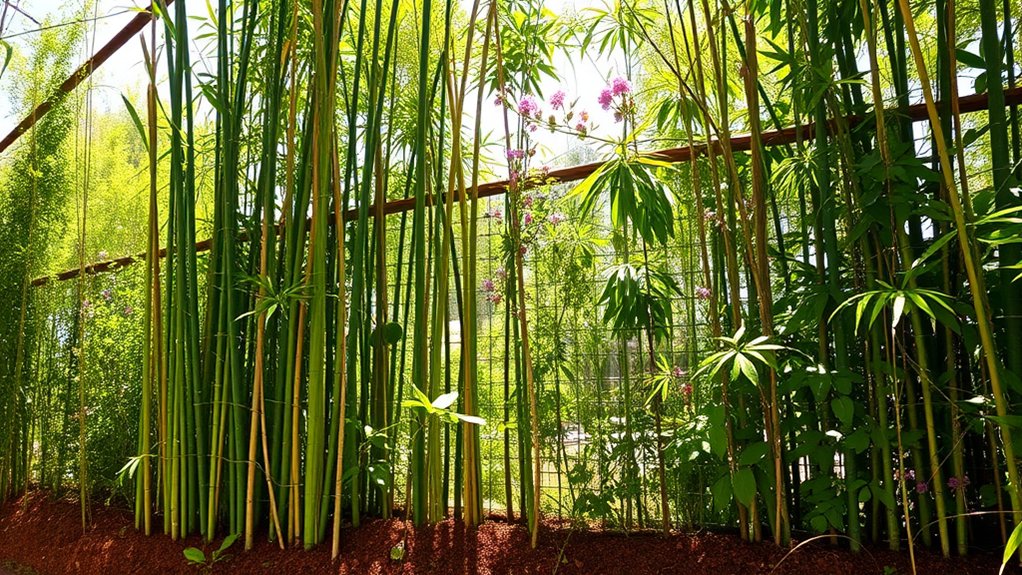
Living fences boost biodiversity by providing homes for different species and act as natural privacy barriers that fit well into your yard.
They need fewer resources than traditional fences, requiring less upkeep and no chemicals.
Opting for living fences is a smart, eco-friendly choice that benefits your property and the environment.
Biodiversity Enhancement
Consider the benefits of living fences for biodiversity enhancement. These natural barriers create habitats for beneficial insects and pollinators and connect fragmented ecosystems.
By incorporating native plants, you boost genetic diversity and support local habitat restoration. Living fences improve soil health, reduce erosion, and create microclimates that encourage diverse plant growth. They also provide refuge for native plants, increasing local biodiversity.
Choosing living fences not only promotes a healthier environment but also offers practical benefits like improved land productivity and less need for artificial fencing materials.
Natural Privacy Barriers
If you want to enhance your privacy and help the environment, consider natural privacy barriers like living fences.
Plants such as bamboo, yews, and arborvitae create dense, attractive screens that block noise and improve air quality. They also support local wildlife and pollinators.
Living fences change with the seasons and can be shaped to fit your landscape. While they need some upkeep, their long-term benefits and visual appeal make them a smart investment. Unique garden fencing ideas can further enhance the effectiveness of living fences.
Choose a living fence to blend beauty with functionality in your home!
Minimal Resource Use
Living fences are a great way to minimize resource use while still creating effective barriers. By choosing native plants, you support local ecosystems and reduce the need for chemical treatments.
These fences are durable and resistant to pests like termites, making them a long-lasting option. They help prevent soil erosion, regulate microclimates, and boost biodiversity by attracting wildlife.
With regular pruning and careful plant selection, living fences offer both functionality and beauty, benefiting your landscape and the environment.
Recycled Metal Fencing

Recycled metal fencing is a smart, eco-friendly option for homeowners who value durability. By choosing materials like aluminum or steel, you help reduce waste and support metal recycling efforts.
| Benefit | Description | Impact |
|---|---|---|
| Recyclability | Made from 100% recyclable metals | Less need for new materials |
| Longevity | Lasts 30-50 years, reducing the need for replacements | Saves resources over time |
| Energy Efficiency | Recycling aluminum uses just 5% of the energy needed for new metal | Cuts down on carbon emissions |
| Low Maintenance | Resistant to rot and pests, requiring little upkeep | Minimizes chemical use |
Choosing recycled metal fencing gives you a long-lasting, low-maintenance solution while supporting sustainable practices. Additionally, aluminum’s long lifespan ensures that your investment will pay off over many years.
Salvaged Wood Fencing
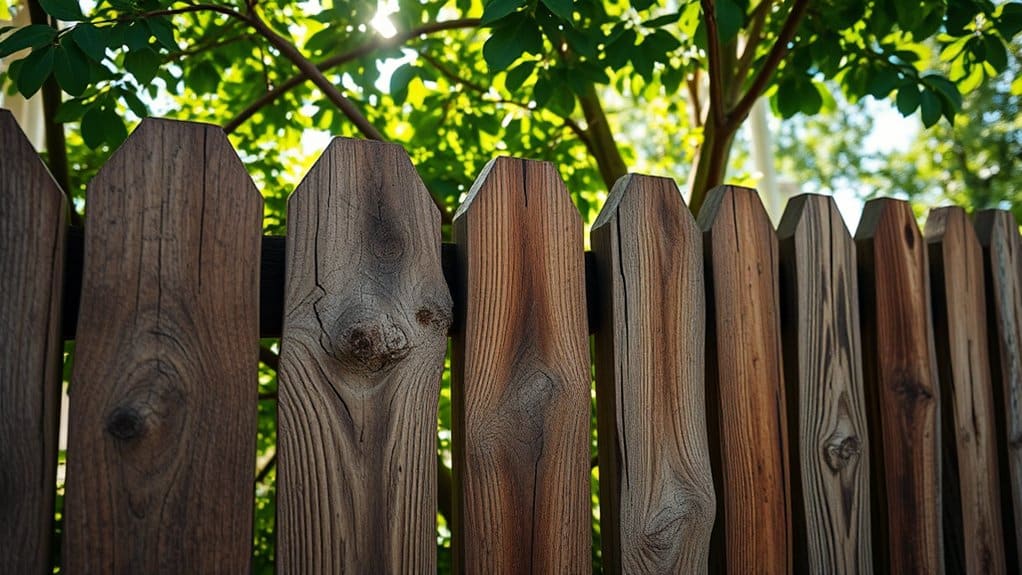
Salvaged wood fencing is an excellent eco-friendly choice.
It minimizes waste and conserves resources while giving your property a unique look.
Additionally, it’s often more affordable and promotes sustainable practices, making it a great option for enhancing your outdoor space.
Environmental Benefits
Choosing salvaged wood fencing not only beautifies your property but also brings important environmental benefits.
By using salvaged wood, you help reduce landfill waste and cut greenhouse gas emissions by about 33%, since it requires less energy to produce than new lumber. This choice supports sustainable sourcing and helps protect forests for future generations. Additionally, it contributes to the aesthetic appeal of your home, as wood can be painted or stained to match your personal style.
Furthermore, it strengthens local economies and encourages a closed-loop system by giving materials a second life.
With lower maintenance costs and lasting durability, salvaged wood is a smart and eco-friendly choice for homeowners.
Unique Aesthetic Appeal
Salvaged wood fencing not only benefits the environment but also adds a distinct aesthetic that enhances your property’s appeal. Its rustic charm, marked by unique textures and history, brings character to your space. You can personalize it to suit your style, combining it with materials like metal for a contemporary look.
| Feature | Benefit |
|---|---|
| Unique Texture | Adds character and depth |
| History and Story | Enhances property charm |
| Rustic Appeal | Complements various styles |
| Blend with Nature | Harmonizes with landscapes |
| Artistic Expression | Encourages creative design |
Cost-Effective Solution
If you’re searching for an affordable fencing option, salvaged wood fencing is a smart choice that offers both quality and style.
Here are some key benefits:
- Lower Initial Costs: Salvaged wood is typically cheaper than new materials, helping you stick to your budget.
- Less Waste: Reusing wood reduces the amount of debris in landfills.
- Ongoing Savings: It generally requires less maintenance, saving you money in the long run.
- Eco-Friendly: Choosing salvaged wood supports sustainable practices and helps protect forests.
Using salvaged wood for your fence not only saves you money but also boosts your property’s look and supports the environment.
It’s a practical and attractive option worth considering!
Bio Composite Fencing
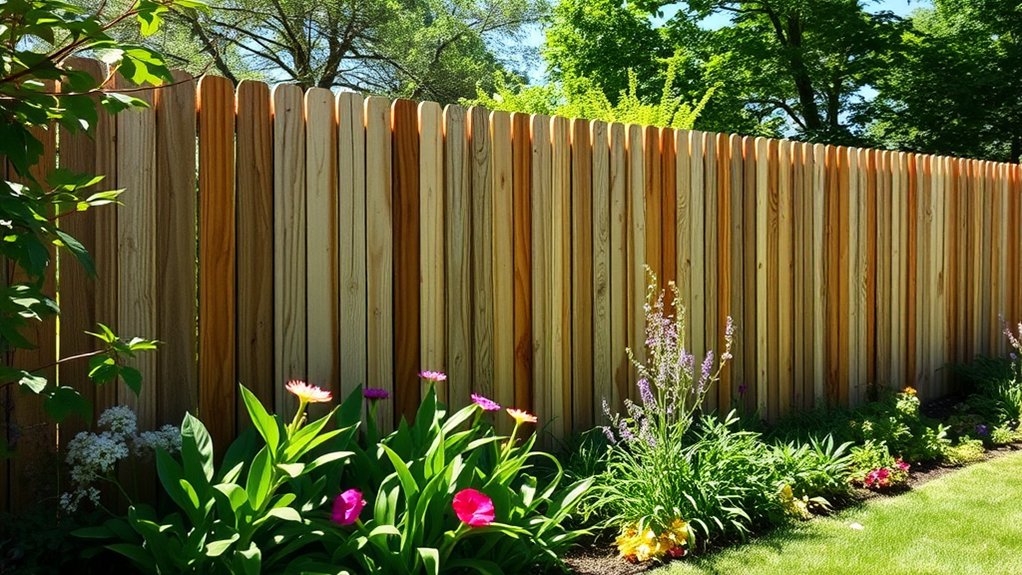
When looking for fencing options, consider bio composite fencing. This innovative choice combines sustainability with durability, using recycled plastics and organic fibers. It’s a great fit for various applications, as it resists rot and insect damage while resembling wood without the upkeep.
| Feature | Benefits | Applications |
|---|---|---|
| Durability | Long-lasting and weather-resistant | Homes and businesses |
| Low Maintenance | No need for painting or staining | Farms and ranches |
| Eco-Friendly | Reduces waste and supports recycling | Parks and public areas |
Bio composite fencing is a practical and cost-effective option for your sustainable living project.
Stone Fencing

If you’re looking for a strong and attractive fencing option, consider stone fencing. It offers durability and is eco-friendly, making it suitable for any climate.
Here are four reasons to think about stone fencing:
- Timeless Look: Its natural beauty enhances your yard and fits in with the surroundings.
- Easy Care: Minimal maintenance means you’ll save time and money over the years.
- Eco-Friendly: Sourcing stone locally cuts down on transportation emissions and benefits local wildlife.
- Supports Wildlife: Stone fences create habitats for small animals, helping to boost local biodiversity.
Recycled Plastic Fencing
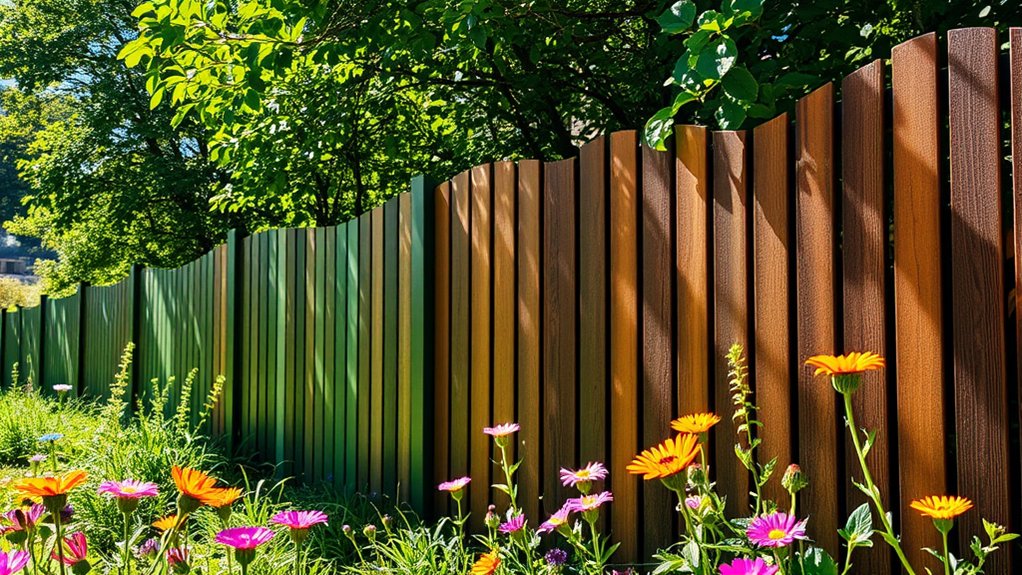
Recycled plastic fencing is an excellent choice for homeowners who prioritize durability and sustainability. Made from repurposed plastic, it helps reduce landfill waste while offering long-lasting benefits. With a lifespan of 20 to 50 years, it decreases the need for frequent replacements and low maintenance efforts. It also stands up to harsh weather, making it suitable for various outdoor applications.
| Benefits | Features |
|---|---|
| Reduces landfill waste | Long-lasting (20-50 years) |
| Weather resistant | Low maintenance |
| Pest and moisture resistant | Aesthetically pleasing options |
Cap-Composite Fencing
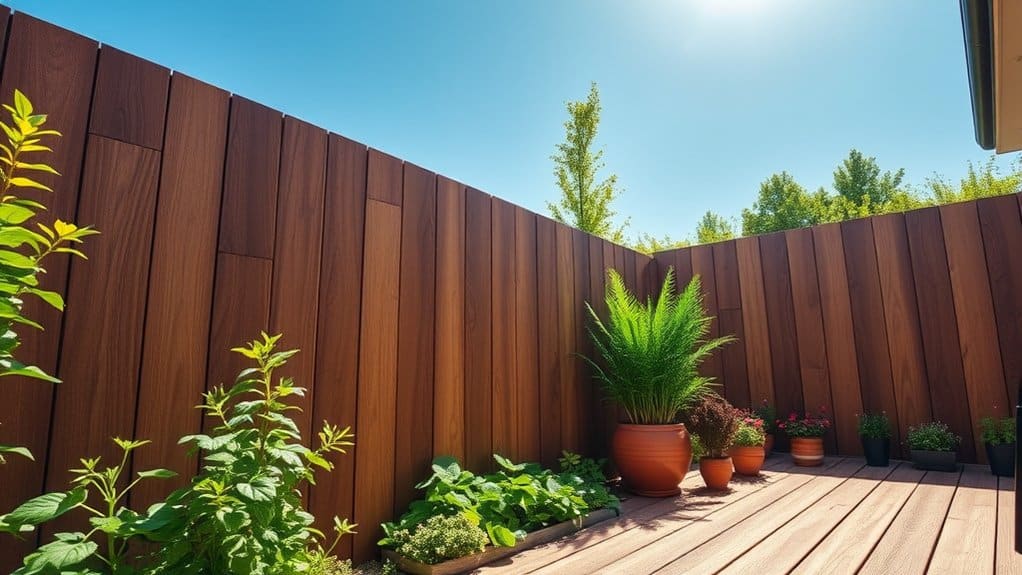
Cap-composite fencing is a great choice for homeowners seeking style and sustainability. This eco-friendly option uses recycled materials, making it both attractive and responsible.
Here are some key benefits:
- Durability: Lasts over 30 years and is resistant to rot and pests.
- Low Maintenance: Simply wash with soap and water to keep it looking new.
- Eco-Friendly: Made from recycled plastics and sustainably sourced wood fibers, reducing environmental impact.
- Aesthetic Variety: Comes in various colors and designs to match your home’s style.
With its sustainable installation and numerous advantages, cap-composite fencing is a smart investment for your property and the planet.
You can feel good knowing you made a responsible choice!
Woven Hurdle Fencing
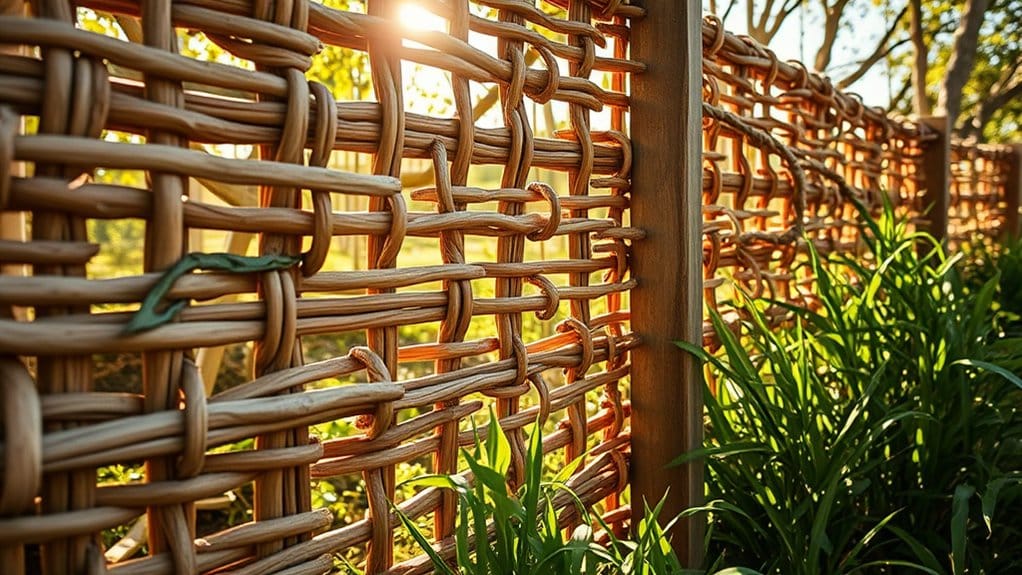
Woven hurdle fencing combines tradition with sustainability, making it a great option for eco-friendly homeowners.
Made from materials like willow and hazel, this fencing is biodegradable and leaves no harmful residues. Its rustic look enhances your garden’s natural beauty while offering a sustainable aesthetic.
Lightweight and easy to install, it’s ideal for DIY projects and can adapt to irregular shapes. Plus, it requires little maintenance, helping you save resources and reduce chemical use.
With a lifespan of about eight years, woven hurdle fencing is both durable and eco-friendly, creating a charming boundary for your outdoor space.
Frequently Asked Questions
How Do Eco-Friendly Fences Compare in Cost to Traditional Fencing?
Eco-friendly fences might have a higher initial cost, but they often require less maintenance and last longer, leading to savings over time. For example, while a traditional wooden fence may need regular staining or painting, a composite or bamboo fence can endure the elements with minimal upkeep. Consider the long-term savings and environmental benefits when budgeting for your fencing needs.
Can Eco-Friendly Materials Withstand Extreme Weather Conditions?
Eco-friendly materials can withstand extreme weather conditions effectively. For instance, vinyl and bamboo are known for their durability, making them great choices for outdoor use. They offer resilience against harsh weather while being environmentally friendly.
Are There Specific Regulations for Installing Eco-Friendly Fences?
Yes, you need to follow specific regulations for eco-friendly fences. Make sure your installation meets local laws, uses sustainable materials, and allows wildlife to pass through. For example, using bamboo or recycled wood can be a great choice. This way, you create a fence that’s both responsible and functional.
How Can I Recycle My Old Fencing Materials Responsibly?
To recycle your old fencing materials responsibly, check with local recycling centers for available options. You can also get creative by repurposing them into garden features like planters or trellises. Always follow local regulations to reduce landfill waste effectively. Make a positive impact!
What Are the Best Eco-Friendly Options for Privacy Fencing?
For eco-friendly privacy fencing, bamboo and recycled wood are top choices. Bamboo is strong, sustainable, and adds a natural look to your yard. Recycled wood not only looks great but also reduces waste. Both options provide privacy while being kind to the environment.
Conclusion
Eco-friendly fencing can enhance your property while being kind to the planet. Materials like bamboo and recycled metal not only protect your space but also contribute to sustainability. By choosing these options, you’re not just enclosing your yard; you’re making a responsible choice for the environment. Let your fence reflect your commitment to a greener future.




